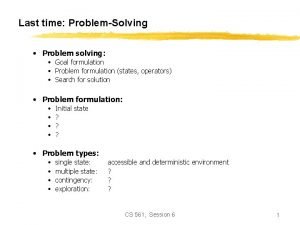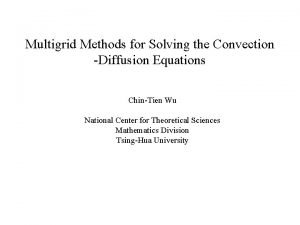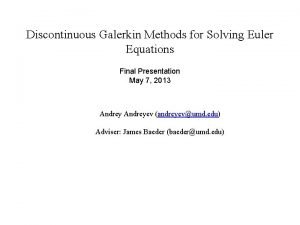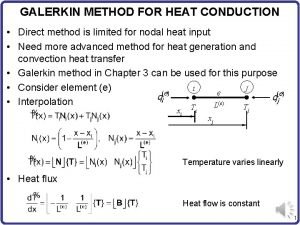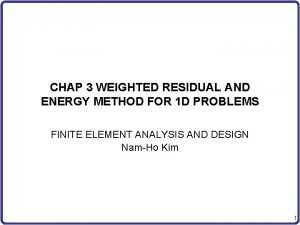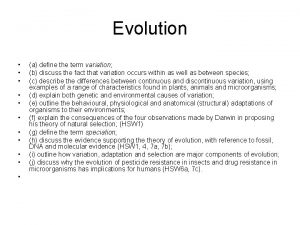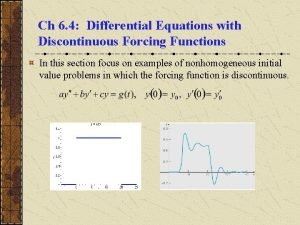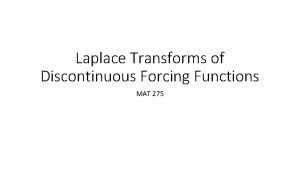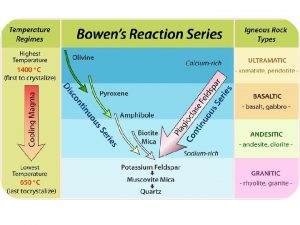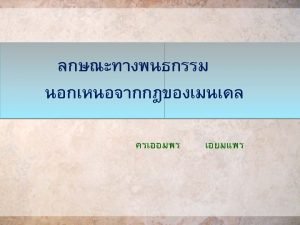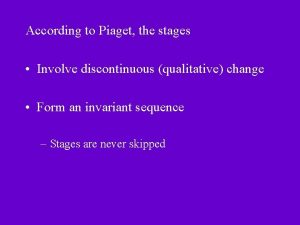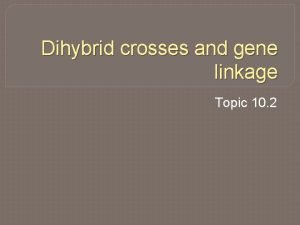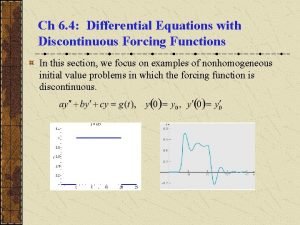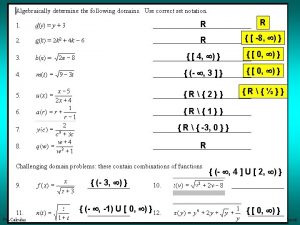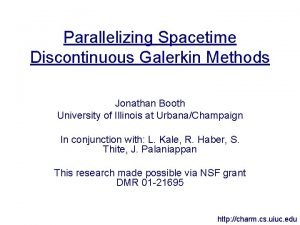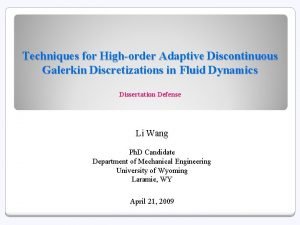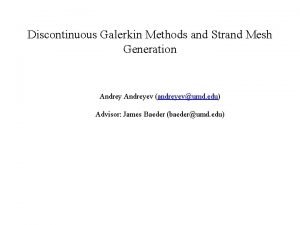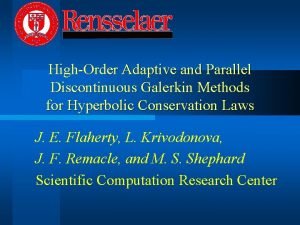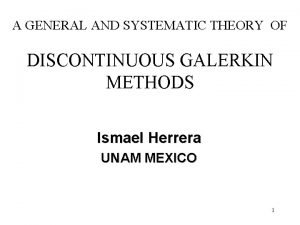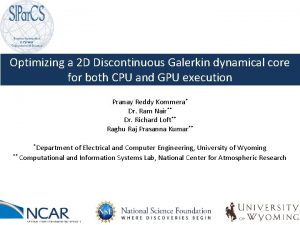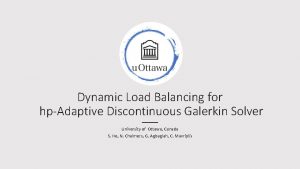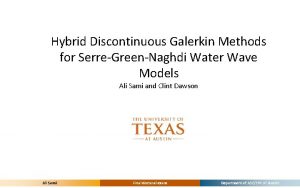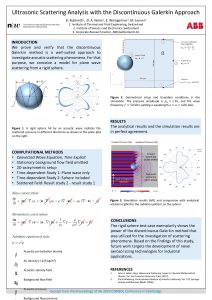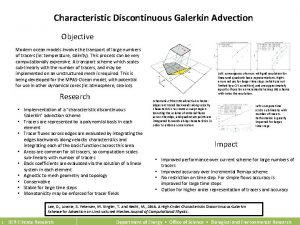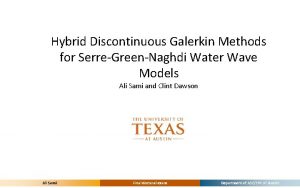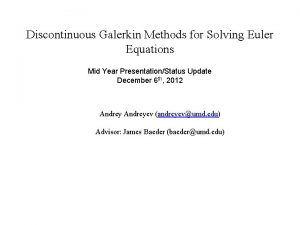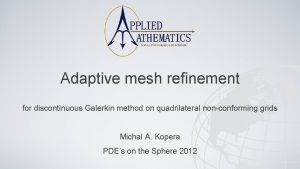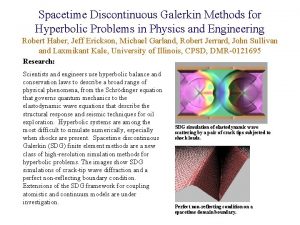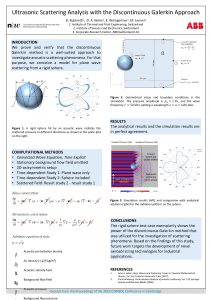A New Discontinuous Galerkin Formulation for KirchhoffLove Shells


















- Slides: 18

A New Discontinuous Galerkin Formulation for Kirchhoff-Love Shells L. Noels Aerospace and Mechanical Engineering Department University of Liège Belgium R. Radovitzky Department of Aeronautics and Astronautics Massachusetts Institute of Technology Cambridge, MA 9 th US National Congress on Computational Mechanics San Francisco, California, USA, July 23 -26, 2007 University of Liège

Introduction • Discontinuous Galerkin methods – Finite-element discretization allowing for inter-elements discontinuities – Weak enforcement of compatibility equations and continuity (C 0 or C 1, …) through interelement integrals called numerical fluxes – Stability is ensured with quadratic interelement integrals • Applications of DG to solid mechanics – Allowing weak enforcement of C 0 continuity: • Non-linear mechanics (Noels and Radovitzky 2006; Ten Eyck and Lew 2006) • Reduction of locking for shells (Güzey et al. 2006) • Beams and plates (Arnold et al. 2005, Celiker and Cockburn 2007) – Allowing weak enforcement of C 1 continuity (strong enforcement of C 0): • Beams and plates (Engel et al. 2002) • Strain gradient continuity (Molari et al. 2006) 2 University of Liège

Introduction • Purpose of the presentation: to develop a DG formulation – – – for Kirchhoff-Love shells, which is a C 0 displacement formulation, without addition of degrees of freedom, where C 1 continuity is enforced by DG interface terms, which leads to an easy implementation of the shell elements in the reduced coordinates, – without locking in bending • Scope of the presentation – – – Kirchhoff-Love shells DG formulation Numerical properties Implementation Numerical examples 3 University of Liège

Kirchhoff-Love shells • Kinematics of the shell – Shearing is neglected – Small displacements formulation – Resultant linear and angular equilibrium equations and in terms of the resultant stress components , and , with and are the resultant applied tension and torque 4 University of Liège

Kirchhoff-Love shells • Constitutive behavior and BC – Resultant strain components high order – Linear constitutive relations – Boundary conditions and 5 University of Liège

Discontinuous Galerkin formulation • Hu-Washizu-de Veubeke functional – Polynomial approximation uh Pk ⊂ C 0 – New inter-elements term accounting for discontinuities in the derivatives 6 University of Liège

Discontinuous Galerkin formulation • Minimization of the functional (1/2) – With respect to the resultant strains and – With respect to the resultant stresses and Discontinuities result in new terms (lifting operators) and in the introduction of a stabilization parameter b. – With respect to the displacement field 7 balance equation (next slide) University of Liège

Discontinuous Galerkin formulation • Minimization of the functional (2/2) – With respect to the displacement field uh – Reduction to a one-field formulation with Mesh size 8 University of Liège

Numerical properties • Consistency – Exact solution u satisfies the DG formulation • Definition of an energy norm • Stability with C>0 if b > Ck, Ck depends only on k. • Convergence rate of the error General – Energy norm: – L norm: L 2 k-1 ≥ k-1 9 in the mesh size hs Pure bending k-1 Pure membrane k Motivates the use of quadratic elements k+1 (if k>2) k+1 (if k>0) University of Liège

Implementation of 8 -node bi-quadratic quadrangles • Membrane equations – Solved in (x 1, x 2) system – 3 X 3 Gauss points with EAS method or 2 X 2 Gauss points • Bending equations – Solved in (x 1, x 2) system – 3 X 3 or 2 X 2 Gauss points – Locking taken care of by the DG formulation Straightforward implementation of the equations 10 University of Liège

Implementation of 8 -node bi-quadratic quadrangles • Interface equations – Interface element s solved in x 1 system – 3 or 2 Gauss points – Neighboring elements Se– and Se+ evaluate values (Dt, d. Dt, r, dr, Hm) on the interface Gauss points and send them to the interface element s – Local frame (j 0, 1, j 0, 2, t 0) of interface element s is the average of the neighboring elements’ frames 11 University of Liège

Implementation of 16 -node bi-cubic quadrangles • Membrane equations – Solved in (x 1, x 2) system – 4 X 4 Gauss points (without EAS method) • Bending equations – Solved in (x 1, x 2) system – 4 X 4 Gauss points • Interface equations – Interface element s solved in x 1 system – 4 Gauss points 12 University of Liège

Numerical example: Cantilever beam (L/t = 10) • 8 -node bi-quadratic quadrangles Membrane test Bending test – Bending test: • Instability if b ≤ 10 and locking if b > 1000 • Convergence rate k-1 in the energy-norm and k+1 in the L 2 -norm 13 University of Liège

Numerical example: Plate bending (L/t = 100) • 8 -node bi-quadratic quadrangles Clamped/Clamped . Sym . . Sym. Supported/Supported Sym Sym. Supported/Clamped – Instability if b ≤ 10 and locking if b > 1000 14 University of Liège

Numerical example: Pinched ring (R/t = 10) • 8 -node bi-quadratic quadrangles Bending and membrane coupling • Instability if b ≤ 10 • Convergence: k-1 in the energynorm and k in the L 2 -norm 15 University of Liège

Numerical example: Pinched open-hemisphere (R/t = 250) 8 -node bi-quad. 16 -node bi-cub. Double curvature • Instability if b ≤ 10 • Locking if b > 1000 (quad. ) and if b > 100000 (cubic) • Convergence in L 2 norm: k+1 16 University of Liège

Numerical example: Pinched cylinder (R/t = 100) 8 -node bi-quad. 16 -node bi-cub. Complex membrane state • Instability if b ≤ 10 • Locking if b > 10000 (quad. ) and if b > 100000 (cubic) • Convergence in L 2 -norm: k 18 University of Liège

Conclusions • Development of a discontinuous Galerkin framework for Kirchhoff -Love shells: – Displacement formulation (no additional degree of freedom) – Strong enforcement of C 0 continuity – Weak enforcement of C 1 continuity • Quadratic elements: – Method is stable if b ≥ 100 – Bending locking avoided if b ≤ 1000 – Membrane equations integrated with EAS or Reduced integration • Cubic elements: – Method is stable if b ≥ 100 – Bending locking avoided if b ≤ 100000 – Full Gauss integration • Convergence rate: – k-1 in the energy norm – k or k+1 in the L 2 -norm 20 University of Liège
 Why problem formulation follow goal formulation
Why problem formulation follow goal formulation Galerkin
Galerkin Spatial discretization
Spatial discretization Galerkin method
Galerkin method Galerkin method
Galerkin method Discontinuous measurement rbt
Discontinuous measurement rbt Why are atomic emission spectra discontinuous
Why are atomic emission spectra discontinuous Nature v. nurture definition
Nature v. nurture definition Physiological adaptation example
Physiological adaptation example Differential equations with discontinuous forcing functions
Differential equations with discontinuous forcing functions Lifespan development a psychological perspective
Lifespan development a psychological perspective Discontinuous forcing functions
Discontinuous forcing functions Bowen's reaction series describes
Bowen's reaction series describes Continuous variation graph
Continuous variation graph Discontinuous variation
Discontinuous variation Piaget discontinuous development
Piaget discontinuous development Difference between continuous and discontinuous variation
Difference between continuous and discontinuous variation Differential equations with discontinuous forcing functions
Differential equations with discontinuous forcing functions Discontinuous development psychology
Discontinuous development psychology
